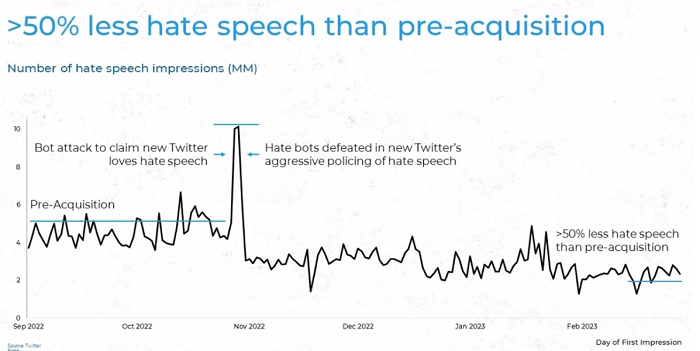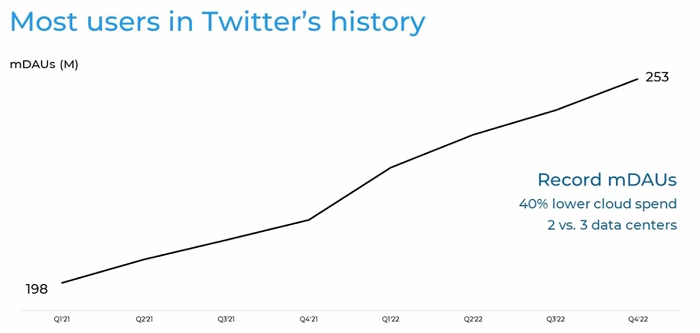While Twitter isn’t sending a huge delegation to meet with ad execs in Cannes this week, the company is on a mission to win back advertiser trust, amid ongoing changes to the platform’s ad policies and content approach under new owner Elon Musk.
Twitter’s decision to hire long-time ad industry leader Linda Yaccarino as CEO is a clear sign that it’s moving in this direction, despite Musk’s own aversion to ads, while it’s also a signal that Musk’s initial effort to reduce Twitter’s reliance on ad dollars hasn’t worked out as he had initially hoped.
Indeed, while Twitter’s various subscription programs are now providing new revenue streams for the company, they only represent a fraction of the revenue that it brings in from ads. And with fewer than 1% of Twitter users paying to use the app, it seems that Musk and Co. are now re-focusing on their pitch to ad partners, via various pledges and insights designed to reassure them that, despite Musk’s changes, Twitter remains a safe promotional pathway.
First off, Twitter has noted that it’s meeting with more brand safety and suitability providers, in order to provide more independent assurance.
Twitter says that it’s currently in the process of assessing new services from Zefr, Integral Ad Science, DoubleVerify, and Unitary, that would give advertisers more control over the placement of their ads within the app.
Twitter already works with Integral Ad Science and DoubleVerify on ad measurement, and it says that, according to their independent analysis, 99% of measured Twitter ad impressions now appear adjacent to content ‘deemed safe in accordance with the GARM brand safety floor’.
In other words, despite industry speculation, Twitter under Elon is actually providing a brand-safe environment, as measured by independent analysis, which could provide some assurance for advertisers considering their Twitter efforts.
That, according to Twitter, has also seen more advertisers coming back to the app, with more than 75% of the platform’s top 100 advertisers now running Twitter campaigns again. That’s an improvement on earlier this year, when reports suggested that 50% of Twitter’s top 100 had halted all ad spend due to safety concerns.
Though that still doesn’t equate to spending, with The New York Times reporting that Twitter’s ad revenue in April was down 59% year-over-year, which, based on current projections, doesn’t appear to have improved a lot since.
So it’s a tale of two stats – on one hand, more advertisers are coming back to Twitter, but the spend data suggests that they’re still being very cautious about their campaigns, as Musk continues to implement new ad rules on a whim, which is another element that Twitter needs to address.
Indeed, over the weekend, Musk implied that Twitter would soon implement new rules around brands trying to use comments on popular tweets as ‘free advertising’. This came in response to users alerting Musk to seemingly scammy replies, but instituting rules to combat such may also end up impacting some legitimate tweet strategies.
There’s been no update on this front as yet, but it’s another example of how Elon’s reactive rule changes continues to cause unease among some ad partners.
Another concern on this front is hate speech, which Twitter itself claims has reduced significantly since Musk took over at the app.

Various experts have refuted these claims, and interestingly, Musk has seemingly watered down his statements on this front, noting in an interview last week that hate speech visibility has declined 30% since the acquisition, not 50% as he shared in March.
At least some of the variability here comes down to how hate speech is measured, with Twitter seemingly employing different measurement approaches that reduce the overall figures. Maybe, this revised number from Elon shows that Twitter’s now updated its approach on this front again, which could be more in line with general industry standards around such.
But really, it’s difficult to know what Twitter’s numbers actually represent, because Elon himself has flip-flopped on various key stats several times, depending on how it serves him in the moment.
As you’ll recall, in July last year, when Elon tried to renege on his $44 billion offer for the app, he claimed that Twitter’s mDAU count was actually radically incorrect, because there were far more bot profiles in the app that Twitter was reporting.
Twitter had long held that the number of fake profiles in the app didn’t exceed 5% of its total mDAU count, based on its own sampling, but Musk claimed that it was actually far higher, with around 33% of its active profiles being fakes, based on his own research and analysis.
Musk eventually settled on it being a more modest 20% of Twitter profiles that he believed, based on his team’s analysis, were fake, which, at that time, would equate to 50.6 million users, reducing Twitter’s actual human user count to around 187m.
Yet, shortly after Musk took over at the app, he abandoned those claims altogether, and instead reported that Twitter had reached a new record high in mDAU numbers.

So what happened to all the bots? Was that a lie that Elon was telling just to get out of the deal, or does it now better serve Twitter to claim all of these profiles as real users, as it could help it lure more ad spend?
With this in mind, it’s hard to know exactly what any of these numbers represent, as Twitter has seemingly switched up its stance based on what it prefers at any given time.
Which is why third-party verification is important, and it’ll be worth noting, over time, what these ad data providers show, in regards to brand safety and reach, as a means to win back jittery ad partners.
Essentially, it’s unclear what Twitter’s communicated data represents at any given time, based on the significant variances reported. This is another element that Yaccarino will have to get more aligned as she looks to enhance Twitter’s pitch to brand partners.



